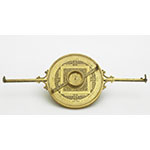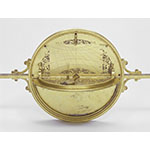Surveying compass built by Baldassarre Lanci, an engineer employed by the Medici. The maker's name, "INVENTVM ET OPVS BALDASSARRIS," is lightly etched on the outer rim of the circular plate. Only the letter "V" of "OPVS" is punched, clearly indicating an unfinished work. The instrument consists of a circular plate whose circumference is divided into eight 45° sectors, corresponding to the eight directions of the winds. The east-west axis carries two long rods with sights that are also fitted with two small cylindrical guides, in which a long brass stylus may have slided. Like Lanci's surveying instrument (inv. 152, 3165), this compass also probably served for making perspective drawings. The stylus was presumably used to plot the points of the sighted object on the sheet of drawing paper. Inside the circumference, along with the windrose, is the shadow square. A circular crown, hinged at the center, carries a diopter that housed a compass, now missing. The instrument was mainly used for surveying and for measuring distances and heights. The verso of the central round section folds along a hinge. One half contains a dial with gnomon; the other contains a toothed wheel with a moving index. The inscriptions are in Italian. This finely decorated instrument is illustrated in Antonio Santucci's Trattato di diversi istrumenti matematici, a manuscript datable to 1593. Provenance: Medici collections.











